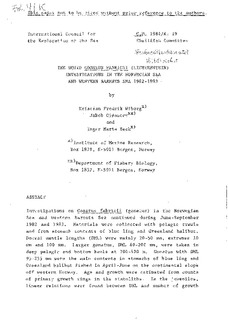| dc.description.abstract | Investigations on gonatus fabricii (gonatus) in the Norwegian Sea and western Barents Sea continued during June-September 1982 and 1983. Materials were collected with pelagic trawls and from stomach contents of blue ling and Greenland halibut. Dorsal mantle lengths (DML) were mainly 20-50 mm, extremes 10 mm and 100 mm. Larger gonatus, DML 80-200 mm, were taken in deep pelagic and bottom hauls at 200-400 m. Gonatus with DML 95-255 mm were the main contents in stomachs of blue ling and Greenland halibut fished in April-June on the continental slope off western Norway. Age and growth were estimated from counts of primary growth rings in the statoliths. In the juveniles, linear relations were found between DML and number of growth rings, but with varying slopes of the regression lines, and correlation coefficients, r, varying from 0.47 to 0.67. In larger gonatus, the regression curve had a sigmoid shape. The assumption that larger gonatus, having. left the surface layers, grow considerably faster than the juveniles, seems to be confirmed. The relationship between total statolith length .(TLS) and DML, both in mm, was calculated for various length groups with the following results:
DML 10-250 mm: TLS = 0.131 DML 0.47, n = 201, r²=0.93
DML 10- 69 mm: TLS = 0.104 DML 0.53, n = 163, r²=0.93
DML 70-250 mm: TLS = 0.328 DML 0.26, n = 38, r²=0.74
There is a considerable change in the relationship for DML longer than 70 mm, indicating a slower growth of the stato1iths. The main spawning period seems to be from December to April, on, or near the bottom in 300-700 m depth or more on the continental slopes of the Norwegian Sea, from the west coast of Norway to West-Spitsbergen, and westwards to Iceland and Jan Mayen. The food of juvenile gonatus was dominated by amphipods, Parathemisto sp., but copepods, chaetognaths, euphausiids, pteropods and Pasiphaea sp. were also identified. Larger gonatus also take fry of redfish and pearlside, and smaller gonatus. | en_US |
